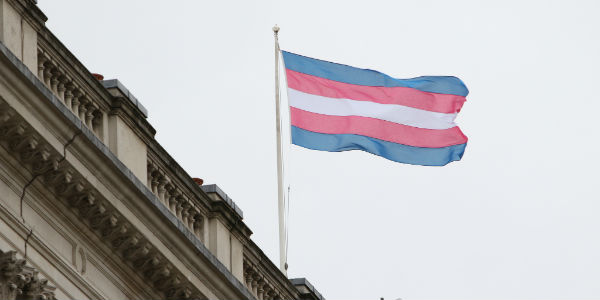Reforming the Gender Recognition Act
In 2017, the British government announced it would consult on amending the Gender Recognition Act 2004 to introduce the principle of self-determination for transgender people. With this process currently stalled amid increasingly acrimonious debates, Peter Dunne sets out the proposed legal reforms and points of contention.

The Transgender Pride Flag flying on the Foreign Office. Picture: Foreign and Commonwealth Office, via a (CC BY 2.0) licence
In 2004 – following high-profile litigation before both domestic and European courts (here and here) – Parliament enacted the Gender Recognition Act. A landmark piece of legislation, it entitles transgender (trans) individuals – that is people who self-identify with a gender that differs from their birth-assigned sex – to obtain formal acknowledgement of their preferred male or female identity (the 2004 Act does not recognise non-binary gender).
At the time of its introduction, this placed the United Kingdom at the vanguard of emerging international movements for trans rights. Departing from all similar statutes across Europe, North America and Australia, the 2004 Act officially recognised preferred gender (referred to as ‘acquired gender’ in the Act) without a requirement for physical medical interventions, such as gender-confirming surgery or mandatory sterilisation. The UK law served as a blueprint for subsequent reforms in other European jurisdictions, including Spain and Portugal.
Almost fifteen years later, however, the Gender Recognition Act no longer stands as a model of international ‘best practice’. In a 2016 report (‘Transgender Equality’) to the UK Government, the House of Commons Select Committee on Women and Equalities identified a number of worrying shortcomings in the current gender recognition rules – both in terms of their practical operation and the core values which they enshrine. In response, the Ministry of Justice announced, in July 2017, that it would initiate a public consultation on the 2004 Act (yet to commence). In November 2017, the Scottish Government also announced that it too would review the existing recognition frameworks, establishing an online consultation process, which closed on 1 March 2018.
Among the possible reforms proposed for the 2004 Act, (at least) two amendments have the potential to create significant political debate.
The first reform would move away from a pathology-based model, where doctors supervise the gender recognition process, towards structures whereby applicants for gender recognition can self-determine their legal gender. Although, under the current UK laws, applicants are not obliged to undergo physical medical intervention, s. 2(1)(a) of the 2004 Act does require proof that an individual ‘has or has had gender dysphoria’ (‘Diagnosis Requirement’). In its 2016 report, the Women and Equalities Committee called upon the Government to ‘bring forward proposals to update the Gender Recognition Act, in line with the principles of gender self-declaration.’ Such a model was first introduced in 2012 by Argentina, and has now been adopted by numerous Western and Northern European jurisdictions, including Ireland, Belgium, Portugal, Sweden, Norway, Denmark and Malta.
There are a number of reasons why trans individuals prefer self-determination models over a framework centred on gender dysphoria. First, diagnosis requirements expressly link trans identities with pathology. While the 2004 Act opens gender recognition entitlements, its coverage only extends to persons who suffer from mental health concerns. For many trans individuals, such a requirement conflicts with their individual experience of gender – that is, they are not distressed about their preferred gender – and stigmatises all identities which deviate from a narrow cisgender (non-trans) norm.
Second, the diagnosis requirement creates practical barriers for many trans individuals who – for social, economic and personal reasons – may be unable to access even basic healthcare services. Existing evidence, both in the United Kingdom and across the European Union, consistently indicates that trans individuals have disproportionately low engagement with medical providers. Applicants for gender recognition are, therefore, ill-placed to satisfy diagnosis requirements.
Finally, many applicants for recognition oppose the symbolism of s. 2(1)(a) of the 2004 Act. By imposing third-party medical supervision, the 2004 Act undermines trans’ understandings of gender. It suggests that trans people are incapable of independently assessing their identity status and need external oversight. This attitude (or at least appearance) of official mistrust is only reinforced through the creation of a Gender Recognition Panel – the body established by the 2004 Act which ultimately determines applications. Many trans individuals favour a model of self-determination because, in removing diagnostic and panel-based supervision, self-declared gender can encourage respect for trans autonomy and personhood.
In recent months, however, proposals for self-determination have come under increasing media and political scrutiny. In particular, some women’s rights groups have argued that self-declared gender is open to abuse, particularly by predatory cisgender males, who will claim a trans identity to improperly enter women-only spaces.
While such a complex, nuanced debate cannot be adequately addressed in a short blog post, it is important to clarify that introducing self-determination into the 2004 Act will, without further parliamentary action, have no impact on existing laws regulating access to women-only spaces (set out in the Equality Act 2010). At present, the 2010 Act already allows trans women to self-determine into their preferred single-gender services. Providers can only exclude trans women where there is a reasonable justification (a high threshold to meet). Self-determination in the 2004 Act will not amend the 2010 Act. If providers can prove a reasonable justification, trans women (even those who have been formally recognised through self-determination) will remain subject to lawful exclusion.
The second contentious reform involves trans minors. Section 1(1) of the 2004 Act currently acknowledges only ‘person[s] of either gender who [are] aged at least 18.’ This means that, without exception, trans children do not (and cannot) come within the terms of the UK’s gender recognition framework.
Much of the apprehension about including minors within the 2004 Act arises from fears that it is not possible, at least in a reliable manner, to identify those young people who, in addition to expressing a trans identity as children, would persist in that status through adulthood. Absolute age-limits are justified as a necessary safeguard against premature applications.
There is no doubt that the welfare of minors should be the paramount consideration in deciding the recognition rights of children. The existing research in this area presents mixed messages vis-à-vis the desirability of reform. On the one hand, there is an important (but not substantial) body of data that suggests that approximately 70% to 80% of children who are ‘diagnosed’ as trans in youth do not continue to express that identity in adulthood. For advocate of minors’ inclusion, this research stands as a stark warning: to the extent that a majority of children who are identified as trans will not develop a trans identity post-majority, there are clear policy justifications for withholding legal transitions.
On the other hand, the existing research is affected by significant defects: it incorporates children who should never have been identified as trans (and who, therefore, are not evidence of ‘desistence’ among trans youth); it includes children who were lost to follow-up among desistence rates (although their current gender identities are unknown) and it fails to consider how peer-pressure forces trans youth (who still identify as trans) to hide their preferred gender.
In the past decade, a growing body of scholarship has emerged which suggests that, where young people have an intense and persistent identification as their preferred gender, they are likely to continue in that identification into adulthood. In jurisdictions, such as Malta, Argentina and Norway, provision has been made to recognise children below the 18-year threshold. In its 2016 report, the Women and Equalities Committee called upon Parliament to begin acknowledging (at least some) adolescents below majority. It remains to be seen whether Parliament will take up this call to act.
This article represents the views of the author and not those of Democratic Audit.
About the author
 Peter Dunne is a lecturer in law at the University of Bristol. His research interests lie in the areas of family law, medical law and European Union law.
Peter Dunne is a lecturer in law at the University of Bristol. His research interests lie in the areas of family law, medical law and European Union law.





 Democratic Audit's core funding is provided by the Joseph Rowntree Charitable Trust. Additional funding is provided by the London School of Economics.
Democratic Audit's core funding is provided by the Joseph Rowntree Charitable Trust. Additional funding is provided by the London School of Economics.